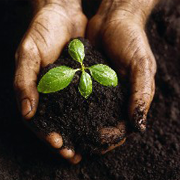|
As garden soil we mean the superficial soil, up to 60 cm depth where plants germinate and grow up. The main categories of soilThe main categories of soil are determined by the percentage composition of these materials.
|
|
|
Rich in organic matter, dark brown color. Ffluffy and easily cultured with good thermal properties, retain heat in winter and not elevate temperature in summer. Absorb and retain moisture easily, while sun and air passes through easily. |
|
Clay soils Dark brown or black, consisting of equal amounts of clay, silt and sand. Extremely soils for cultivation, rich in nutrients for plants. Easily maintain the required amount of water for a long time. As quaternary deposition the silty soils, particularly on the slopes, are extremely unstable and show creepage,a type of slow settling, resulting the presence of bending tree trunks. |
Mixed Soils mixed with all the major components (clay, sand, calcium and organic matter). Are named depending on the dominant material: sandy clay, or clayey humus, humus or sandy humus etc |
|



 Clayey or Red Soil
Clayey or Red Soil
